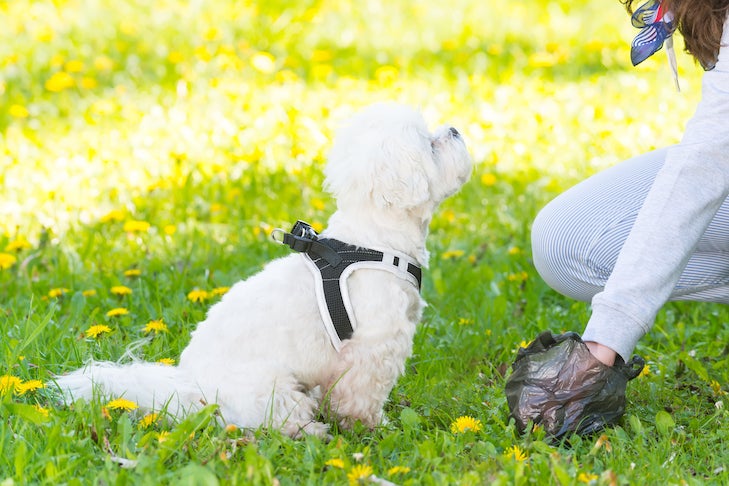
AKC is a participant in affiliate advertising programs designed to provide a means for sites to earn advertising fees by advertising and linking to akc.org. If you purchase a product through this article, we may receive a portion of the sale.
With their habitats and food sources shrinking, coyotes are venturing closer to our neighborhoods and homes than we’d like. Not only do they prey on livestock such as chickens and lambs, but our pets can become prey for these predators, as well. Here are some ways you can protect your dog from coyote attacks, both at home and while you’re out enjoying nature.
Coyote Protection on Walks
Get a Coyote Vest For Your Dog
Coyote vests were created in 2015 after one family lost their small dog to a coyote. They vowed to help reduce the chance of a similar tragedy happening to someone else. Coyote vests are made for small dogs and have a Kevlar neck collar armed with 1-inch spikes and spikes down the back, making it hard for coyotes to get a bite. If you have a small dog, these vests can help provide good protection.
Keep Them on Leash

While you’re out for a walk with your dog, be sure to keep your dog on leash. Most coyotes are wary of people and won’t attack your dog if your pet is close to you. Bringing something along that makes a loud noise — a dog whistle, bell, horn, or something similar — is another good way to scare off a lingering coyote.
Protecting Your Home Against Coyote Attacks
Even if a coyote doesn’t attack your dog, they could still transmit diseases to them if they are carrying one. These could include anything from mange, fleas, ticks, and worms to distemper, rabies, and parvovirus. If you have community meetings, you may want to bring up these tips or suggest creating a Facebook group where neighbors can post coyote sightings.
Don’t Leave Your Dog Outside Unsupervised
If you’re not around to keep an eye on your dog, it’s best to leave them indoors, especially if you don’t have good fencing. This way, they’ll be out of reach of a coyote.
Add Coyote-Proof Fencing to Your Yard
Speaking of fencing, you should invest in one that’s solid, at least 6-feet tall, and buried in the ground at least 18 inches, since coyotes are amazing diggers. At the top, you need to put something that will stop even the most athletic coyote. This could be barbed wire or a tube of PVC pipe (whose slick, round shape is almost impossible for a coyote to grip).
You can also create an overhang on the outside of the fence. Finally, you can install coyote rollers, which are aluminum rods that spin when a coyote tries to grip them, preventing them from climbing over. Coyote rollers won’t make your property look scary in the same way PVC pipe or barbed wire might, and many homeowners’ associations will accept them.
Light Up Your Yard at Night
Another backyard tip is to install motion-sensor lights that are pointed outside your fence line. That way, if a coyote does come around, the light will turn on before they get into your yard. The light will make most coyotes turn back.
Pick Up Poop and Trash

Your dog’s feces can attract coyotes to your property. Cleaning up poop on your property can lower the risk of attracting a coyote. You can use a pooper scooper or poop bags. Coyotes will also eat fallen fruit, so picking up any windfalls is a good idea. It’s a good idea to avoid leaving trash outside in bags. You may want to invest in a secure garbage can with a lock.
Training Your Dog in Case of Coyote Attacks
When faced with a wild animal, even the best-trained dog will struggle not to react. Managing your dog appropriately and working to prevent coyote attacks are the best ways to keep your dog safe. If you believe you might come across a coyote while out for a walk, keep your dog on a leash.
However, you can teach your dog some basic commands that are helpful for all dogs, whether or not there’s a predator approaching. Make sure your dog has a reliable recall. This means your dog comes to you pretty much every time you ask. If a coyote approaches your dog in an off-leash area, you may not have time to get the leash on. Having a reliable recall can save your dog’s life in this type of scenario, so practicing this skill in advance is key. Refresh your dog’s knowledge by playing recall games, using positive reinforcement training methods, and adjusting your verbal command if you have a poisoned cue. “Poisoned cues” are cues that have lost all meaning to your dog, whether through poor reinforcement or lack of repetition.

If your dog tries to chase a coyote, use the “stay” command to make sure they don’t pursue. Regardless of your dog’s size or strength, coyotes are dangerous predators. Plus, they may be carrying dangerous diseases and parasites that you don’t want your dog to contract. Other skills you may want to refresh include teaching your dog to ignore distractions and heel (walk at your side), as well as behaviors you use when you don’t want them to approach other dogs (like an emergency U-turn or getting behind you immediately).
In exciting moments (like a coyote sighting), it may be hard for your dog to focus on you. So you may also want to carry high-value rewards with you, like your dog’s favorite treats or their favorite toy, as a way to reinforce their training.

